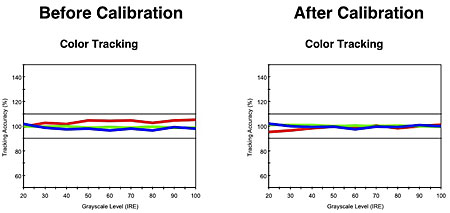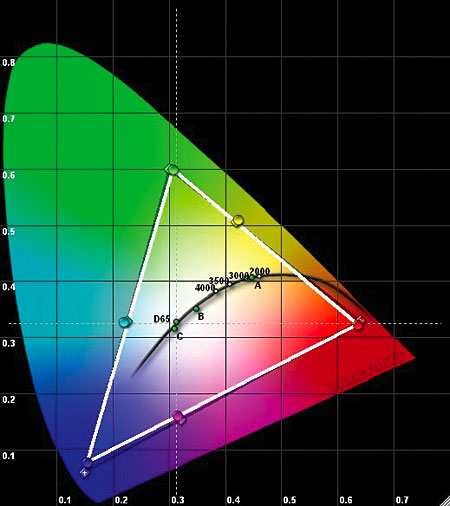Mitsubishi WD-65835 Rear Projection HDTV HT Labs Measures
Full-On/Full-Off Contrast Ratio: 5,005:1
All of the measurements were taken in the Natural mode, adjusted as needed for the most accurate picture.
The Mitsubishi calibrated well. Out of the box, it was better than average in the Low color temperature setting, though with a bit too much red (see Before Calibration, below). A small adjustment in the service mode took care of that and brought the tracking very close to perfection everywhere except the darkest region (below about 30 IRE, see After Calibration, below). The service adjustments are limited, however, in that they only provide overall red, green, and blue control for each color temperature setting and not the more desirable adjustments at the top and bottom of the brightness range. But that proved to be no serious disadvantage here.

Even before I adjusted the set’s color gamut using the PerfectColor and PerfecTint controls, it was very accurate. Following some minor tweaks (performed with test gear), I arrived at the result shown by the white triangle in the pie-shaped CIE chart. The ATSC color standard is shown by the black triangle. This is an extremely precise HD color gamut; the main deviation is a slightly undersaturated blue.

At 1080p and 1080i in HDMI, the Mitsubishi did not respond cleanly to resolutions at the upper limit of the HD bandwidth (37.1 megahertz). The resolution lines were visible at that frequency, but with serious banding and moiré. The response at 18.5 MHz, however, was excellent. 720p resolution patterns looked better than 1080i/p at 37.1 MHz, and 480i and 480p patterns were excellent within their respective, more limited bandwidths. The component resolution was also limited at the highest frequency in 1080i/p.
The set’s fixed overscan averaged between 2 percent and 2.5 percent (on all sides, for a loss of about 8 to 10 percent in the overall image area).—TJN
- Log in or register to post comments






























































